Violet Leaf Balm – For Eczema, Fibrocystic Breasts
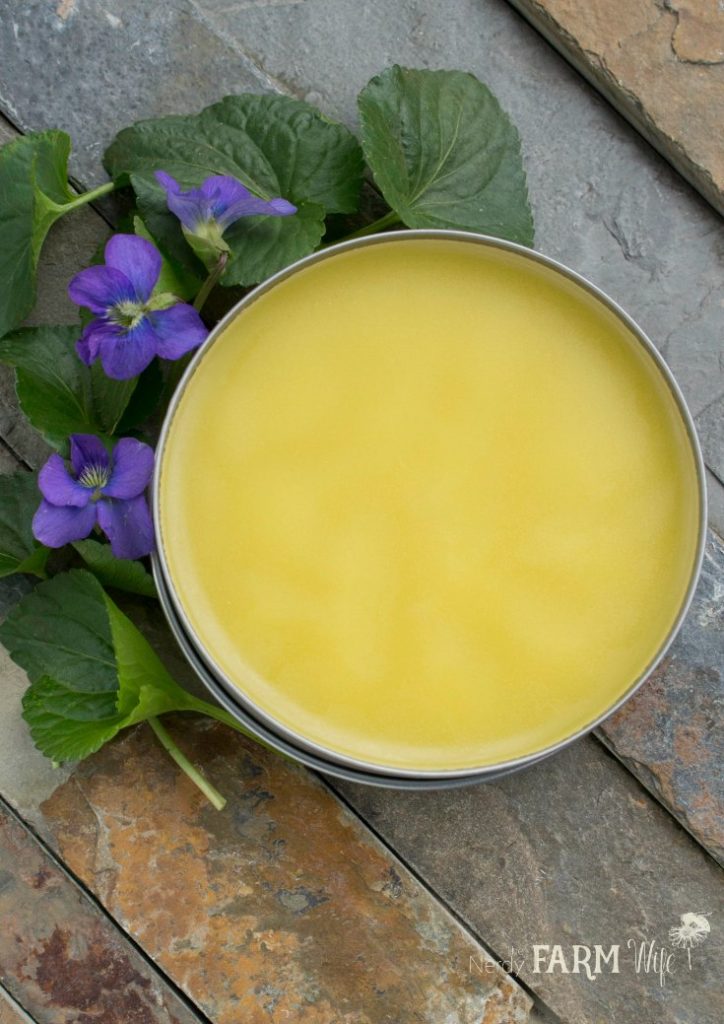
Although violet blossoms are long gone from our area, the leaves have persisted in spite of the dry, hot weather and can still be found flourishing in shady spots around my house.
I’ve touched on it before, but wanted to highlight today just how beneficial those violet leaves can be.
Violet leaf is a wonderful soother of inflamed skin and can help tame rashes, hives & eczema. It can moisturize, tone and heal the skin.
My favorite use for it, however, is in making a balm to help fibrocystic breasts.
This past winter, I had a major freakout moment. I discovered the dreaded-by-all-women lump and fretted about it for a month or two since both my mother & grandmother had breast cancer, then finally went and had a checkup.
My bloodwork was beautiful, I was deemed perfectly healthy, and it was just a very mild case of fibrocystic breast disease. Whew! The naturopath I saw is wonderful and she had many ideas to treat it, however I was broker than broke, so had to rely on a virtually cost-free home remedy if I could find one.
I went home, started researching my options, and discovered that violet leaf was exactly what I needed. At the time, it was growing like crazy around the house, so I picked some, infused an oil with the heat method (described below) and started applying that night.
Within mere days, I felt complete and total relief. I later turned it into a balm which is less messy to apply.
Keep in mind that this is just MY experience and I’m not claiming violet leaf will help everyone. If you have concerns about a lump in your breast, you should definitely see a qualified medical professional immediately.
You should also check your diet, which is the root cause of many symptoms. In my case, in trying to cut budget corners, I switched from real butter to margarine (which is not so good for ANY type of inflammation.) We’ve since resumed eating the real deal and I do think that helped along with the balm.
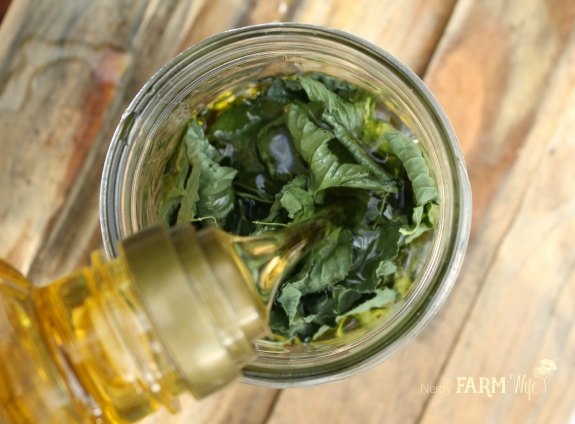
How to Make Violet Leaf Infused Oil
First, gather some fresh, unsprayed violet leaves. Look for where you saw violet blooms in the spring, you should find plenty of the heart-shaped leaves still around.
Spread the leaves in single layers over clean towels or paper towels and allow to air dry for 2 to 3 days. If you don’t have fresh leaves available to dry, you can purchase some from Mountain Rose Herbs.
You can infuse the oil either the slow way (takes about four or six weeks) or the fast way (takes just a few hours.)
For the slow way, place several handfuls of dried violet leaves in a mason jar, cover with a light oil (I like olive or sunflower oil), cap, and let sit in a dark place for four or six weeks, shaking occasionally. Strain into a fresh glass jar and store tightly sealed and in a dark, cool place.
For the fast method: Place your dried leaves in the jar, cover with olive or sunflower oil, but don’t place the cap on yet. Set the jar in a saucepan half filled with water and heat over a low burner for around two to three hours.
You don’t want your water to be hot enough to boil (steam droplets in your oil is not good.)
Don’t let the oil get so hot that you end up deep-frying your leaves and the whole mess smells like burnt parsnips. Trust me, that is not a smell you want to smell! If you accidentally, sorta, kinda do that – like I may have accidentally, sorta, kinda did one time – just toss it and start over.
Once your oil is sufficiently infused, strain out the violet leaves and discard. You can either use this Violet Leaf Oil, as is, or go a step further and turn it into a balm.
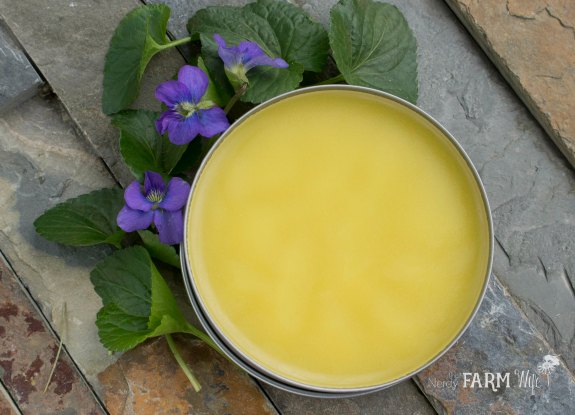
How to Make Violet Leaf Balm
To make a balm, any type of balm, I use roughly 3 1/2 ounces of oil for every 1/2 ounce of beeswax. If I want a softer, looser salve, I use a bit less beeswax. For this violet leaf balm, we want a softer consistency, so it won’t drag across the skin.
- 3 1/2 ounces of violet leaf infused oil
- a bit under 1/2 ounce of beeswax
That’s it! Melt those two together in a heat proof container set into a pan of simmering water, then carefully pour into containers to cool.
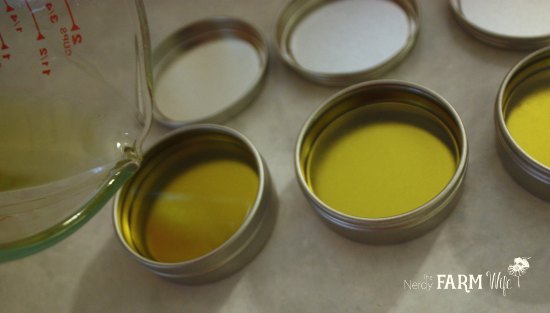
Notes & Tips
I get my tins & jars from Mountain Rose Herbs or Specialty Bottle, but you can also re-purpose a small jelly jar for this use, for more cost savings.
This recipe is very customizable. For example: I sometimes like to add rose leaves or petals to the initial infusing in order to make a Violet-Rose balm. (Roses have tons of skin soothing benefits.)
If you are making this for eczema, I highly recommend including a tablespoon of Tamanu Oil in your 3 1/2 total ounce amount. It is fabulous stuff – great for so many skin conditions!
One more random use: Several months ago, my daughter had a very sore throat and swollen lymph nodes.
I gently massaged Violet Leaf Balm on the outside of her neck a few times a day and she said it helped immensely. This winter, I plan to make the balm and add a few vapor-rub type essential oils like Eucalyptus, Camphor, Rosemary, Lavender & Peppermint to test out on future sore throats & colds.
I hope you get a chance to make and try this great little balm! Just remember it’s for external use only, not for use on open wounds, and not a substitute for qualified medical care!
If you’re pregnant or nursing – check with a doctor before use. While I try my best to make sure the information on this site is correct, it’s up to the individual reader to research an herb thoroughly before use and always check with a medical professional if you have any questions.
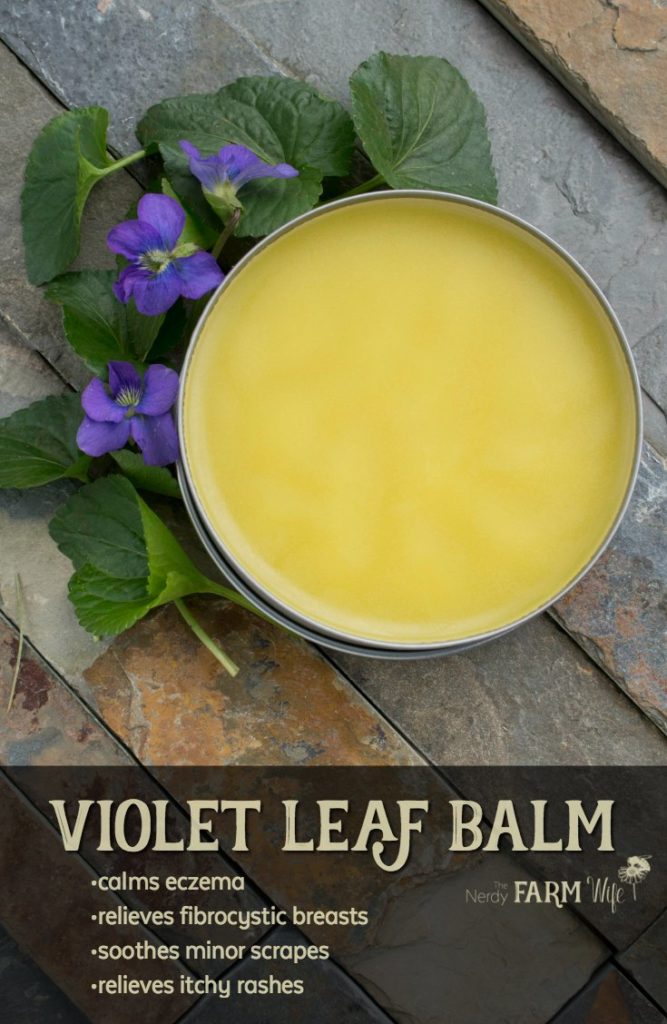


Herbs tend to offer themselves when needed.
What a blessing!
Yes, they do! :)
Thank you for this wonderful recipe; my daughter has been challenged throughout her life with skin issues and so is her 10 year old son. This will be easy to make now before the fall freezing nights in the Rockies send the violets to rest for the winter. A timely and most fabulous recipe and information. I love reading your blog and do not always take time to write but do, in fact, save so much of the information you share in folders.
Kristin
Thank you for the kind words Kristin! :) I love violet leaf infused oil for many things, so have several big jars made up to hopefully last until next spring! I also use it in my Aches & Pains Balm. (Which I’m hoping to type up & post the recipe for tomorrow or Tuesday.)
You should check out opening a store on poppy swap! Thanks for the info – I am definitely making some – I have the same issue! :-)
I hope it helps you some too, Mandy! :) I’ve thought of opening at another place and Poppy Swap looks fantastic, but right now think I’ll give selling a break. (I’m kinda not so great at turning a profit haha.)
Great info! And I am so glad that you found something to help you. :-)
Thank you so much for sharing how you oil infuse your leaves.
I have a dumb question… If I wanted to make a chamomile oil, could I just throw a few chamomile tea bags (or the contents of them) in the oil and do it that way?
Sorry you have to take a hiatus from your etsy shop. :-(
I can’t tell you how happy I am that you are still blogging, though!
Thanks for sharing with my Super Link Party! :-)
Hi Susie! I don’t see why you couldn’t do that – I don’t drink tea (I know, crazy, right?!) :) but I just peeked at Celestial Seasonings Chamomile Tea ingredients online and it only has chamomile in it. So, seems the same thing to me!! :)
Great! Thank you! :-)
And WOW! I am so surprised that you don’t drink tea! LOL
Thank you so much for sharing this on Natural Living Monday.
I have never worked with violet leaves but I will have to try it out!
I LOVE violet leaves! They are so readily available here and have so many benefits. :)
I also had a scare with Fibrocystic Breasts years ago. My doctor told me that caffeine is also a culprit for causing this condition and recommended I cut back on coffee, chocolate, sodas, etc. It helped a great deal.
Yes, great point! I know a lady who also had good results with cutting out caffeine. (though she still eats chocolate!) :)
Fortunately, I don’t like coffee or soft drinks and have to strictly avoid chocolate because it’s a migraine trigger. It makes me think my mild case might have been much worse if I did consume those types of things!
Same here too. Just cut out caffine for awhile. Then drink in moderation.
I cannot wait to make this! I have fibrocystic breasts and the only thing that has remotely helped is taking evening primrose oil. I think this balm in addition will be wonderful! Thank you so much for this recipe!
Hi Cristi, I hope you find it helpful! :)
I received my violet leaves yesterday and made the balm today. It turned out wonderful. I have a couple of questions: 1. Because I used a light olive oil, my balm has a mild olive oil smell. It isn’t bad by any means, but I’m wondering if I could add a fragrance oil to the recipe or maybe use a difference oil for the infusion that has less of a smell than the olive oil? And, 2. Could I use the infused oil in a lotion recipe? Thank you again for this recipe!
I’m glad it turned out well for you! I know what you mean about the smell. You can use other types of oil such as sweet almond or jojoba or perhaps sunflower oil, but you can also add an essential oil such as lavender, rose, bergamot, ylang ylang…. I’d just make sure to use pure essential oils, since it’s meant to absorb in.
You can most definitely use the infused oil in a lotion or cream recipe and also in salves, lip balms and soaps. I use violet leaf oil in everything I can! :)
I am so excited to try this balm recipe this year. I’m wanting to try all sorts of things with it – mints, lavender, eucalyptus, violet leaves, rose petals, etc. I wonder if I could make a balm strong enough to equal Vapo Rub?
Absolutely you can. That’s a recipe I keep meaning to add to the blog. I add eucalyptus, camphor, peppermint, pine, rosemary & wintergreen essential oils to make homemade vapor rub – any or all of those I happen to have on hand, but always the eucalyptus. I just usually judge how much I need by a sniff test; so don’t have exact amounts for you, but you might find a good recipe with suggested amounts via google! Have fun creating all of those great sounding salves! :)
I have the Violet leaves, how can I dry them to use in this balm?
Hi Gail, I use a really low-tech way to dry herbs & flowers. I bring them inside and spread them out in a single layer over white paper towels or a flattened brown paper lunch bag. I check them every day and stir them around a bit, if I think about it, then leave them on my kitchen counter until they’re dry. I hope that helps and good luck making your balm! :)
Thank you so much for this recipe! Two of my daughters have eczema, so I am very excited to try this for them.
I have a couple of questions for you, if you don’t mind. This is the first time I have infused oil. I started the violet leaf infusion yesterday. I felt uncertain how much oil to add with my violet leaves. Should be be just covering the leaves? A few inches over the leaves?
Also, when I heated the oil it turned a very dark color. I heated it on low heat for maybe 4 hours. It never boiled or simmered; it was just warm. Did I heat it too long, or should it turn pretty dark?
Thank you so much for your help! I’d like to try your dandelion salve next. :)
Hi Connie!
You do want to make sure the leaves are well covered, so a few inches over (at least) is good!
Four hours is plenty enough time to infuse the oil – I sometimes stop at two hours, depending on how it’s looking. As long as your oil doesn’t smell like deep fried leaves, then it should be perfectly fine. Sometimes it turns a browner color with the fast method (and is more greener with the slow method.)
I hope you enjoy making your salve!
(and PS I love your blog!) :)
I made some plantain/ spearmint/Coconut oil salve in my crock pot; Heat on HI till warm, 10-15 min, then on
LOW abt. 1/2 Hr. let cool down maybe 1Hr then strain. Any EO can then be added & a little beeswax if you want a firmer cream/salve.
Great idea – thanks for sharing!
I still have violets in bloom in my yard, I wonder if the leaves are better for eczema or the flowers or.. both in combination…
What do you guys think?
Hi Ashley, I like to use the leaves because I have such a good supply of them for much of the year compared to the flowers which are only around for such a short time, but they both have beneficial properties if you want to use them together!
love your testimony about your violet salve remedy for fibrocystic breast..It is funny how the herbs a person needs are plentiful around you..I was very ill some years back & I discovered one day mullein growing right outside my window, I was so sick I could not find the energy to walk out to pick the leaves & flowers to use, it just so happened that it started growing in arms reach when I cranked open my window to pick..
That is amazing! I love how many great remedies are found right around us; when we start to look. It’s wonderful that the mullein was there for you!
I love your blog! It has so much helpful information in it. I am infusing my olive oil as we speak and can’t wait to make the soap and Leaf Balm for Eczema and fibrocystic breasts – as I have both conditions! I have been making soap for 5 years and selling it at craft shows and the Farmers’ Market. People say they love it because it is herbal – yay! I’m always looking for new information to broaden my knowledge and add new scents/colors to my soaps. The possibilities are endless!!!
Hi Kathy, I’m happy to hear that you like the blog! I hope the violet balm and soap recipes work well for you too. I agree; the possibilities for soap making are endless!
I just went out and picked a bunch of the petals.. will they work too?
Hi Emily, The flowers and leaves should have similar properties, but I’m not 100% sure if they’ll work the same in the salve. I usually save the flowers for making things that their color will show through (vinegar, jelly), but if you have a large supply then by all means, experiment and see how you like it! (And, if you remember to, come back and let me know how it turned out – I’d love to know!) :)
Hi! Just wondering if there’s a more specific guideline for infusing (weight/volume) the dried violet leaves and the oil? I’m a little bit paranoid about using this infusion in a nipple cream in case it’s too strong, and on the flipside I want it to actually be effective :) I know it’s not an exact science, and usually I’m fine with “handfuls” and other such measurements, but when babies are involved I guess it doesn’t hurt to be extra prudent. Thank you so much!
Hi Sarah, According to my Making Plant Medicine book by Richo Cech, to make a standardized herbal infused oil, use a 1:5 ratio when making. So, 1 part dry herb (weight in grams) to 5 parts oil (volume in ml). That formula would be used in a practical manner such as: 100 grams dried, crushed violet leaf to 500 ml oil. (Or whatever amount of oil you are aiming for.) The baby should not directly be ingesting any though. You apply a small amount immediately after nursing and wipe off any residue before nursing again. If you have any concerns, ask your doctor or nurse before use. You could also use a plain oil (such as coconut.) You’re right; babies deserve extra caution and special care! :)
This is perfect, thanks! Good to know it’s pretty a pretty universal process for any herb-infused oil. I’ll make a note of this for sure!
You’re welcome! :)
Hi,
Would it be alright to use the flowers and leaves in this recipe. I just went out into the forest and collected about 3 cups of wild violet leaves. Can they also be made in a cough syrup? Thank You. :)
Hi Lily, Sure, you can mix some flowers in too! You can make a cough syrup as well – I have a recipe here: https://thenerdyfarmwife.com/violet-leaf-honey-cough-syrup/
Is there a place to buy the balm for the Fibrocystic breasts. Would love some relief, but no good int he kitchen. Thanks. :-)
Hi Tina! I would check with poppyswap.com first. If they don’t have it, then perhaps someone on Etsy.com does. I hope you find some! :)
I make my oil using a candle warmer hot plate. I heat it for two days. It works great. Sometimes I heat it with plantain weed for the anti itch and drawing out properties of the plantain. Plus they grow together so harvesting is easy.
Hi Carol. That’s a wonderful idea – thanks for sharing that with us!
Hello Jan- I just discovered your website a couple of weeks ago and have been spending inordinate amounts of time pouring over the information here….this is a GREAT site! I do have a question though…I’ve been reading everything you have here about Violets and I want to try everything on the list, BUT…I don’t have any wild violets growing in my yard, but do have some planted in planters, so they don’t overtake anything (hopefully this is a good substitute for yard growing) and I also have TONS of VIOLA and some pansies in the yard, and I’m wondering if these can be used instead of the Violets for these recipes
Hi CA, I’m so happy that you’ve been enjoying the site! From what I’ve read, Violas and pansies are in the same family as wild violets and share quite a few of the same properties & benefits, just in milder form, so I think it’s worth a try substituting. (Just not African violets. They’re different and not good to use.)
Over 20 years ago, I had a very large breast lump and more or less went on a juice fast-doing a minimal of herbal supplements and the lump went away over 6-8 wks {long time ago for me to remember exact time}. I discovered one of the supplements I had been using targeted the liver and lymphatics. This was a very good personal experience for me-maybe this might help others-I’m a HUGE believer in God’s pharmacy! and avoid chemicals for anything unless a last extreme choice.I take NO medications, but recently with severe pain from broken leg + severe torn ligaments+ shattered kneecap, I gave in to ‘ percocet’–I hope I NEVER have to decide to use it or not–HORRID withdrawals for me. I cold-turkeyed the drugs and used LOTS of pain-killing herbs “repeatedly” and did fine + plus they helped inflammation too.
Hi Karan, Thanks for sharing your story with us! That’s wonderful that the lump cleared with such good results! I agree, there are so many plants that we can use that are powerful healers, but still safer and gentle on our bodies. Your broken leg and torn ligaments and shattered kneecap sound so extremely painful, I’m glad that you found some pain-relieving herbs, but I know that must have been quite the ordeal you went through! I hope you’ve all healed up now!
And here I thought the violets in my herb garden were just annoying weeds – they grow like crazy here & just happen to be the state flower! No more weeding out! I have issues with heavy painful breasts during certain phases of my cycle. I’m hoping this will help, because as a home health nurse going bra less is not an option. ;)
Hi Melissa, How wonderful to have so many violets growing around you! I hope they help! :)